Typical values at TA = +25°C, ADC
Sampling Rate = 2949.12 GHz. Default conditions: output sample rate = 491.52 MSPS
(decimate by 6), PLL clock mode with fREF = 491.52 MHz, AIN =
–3 dBFS, DSA setting = 4 dB.

| With
3.6 GHz matching, normalized to 3.6 GHz |
|
Figure 5-366 RX
In-Band Gain Flatness, fIN = 3600 MHz
| With
3.6 GHz matching |
| Differential Amplitude Error = PIN(DSA
Setting – 1) – PIN(DSA Setting) + 1 |
Figure 5-368 RX
Uncalibrated Differential Amplitude Error vs DSA Setting at 3.6 GHz
| With
3.6 GHz matching |
| Integrated Amplitude Error = PIN(DSA
Setting) – PIN(DSA Setting = 0) + (DSA
Setting) |
Figure 5-370 RX
Uncalibrated Integrated Amplitude Error vs DSA Setting at 3.6 GHz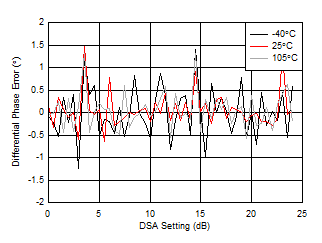
| With
3.6 GHz matching |
| Differential Phase Error = PhaseIN(DSA
Setting – 1) – PhaseIN(DSA Setting) |
Figure 5-372 RX
Uncalibrated Phase Error vs DSA Setting at 3.6 GHz
| With
3.6 GHz matching |
| Integrated Phase Error = Phase(DSA Setting) – Phase(DSA
Setting = 0) |
Figure 5-374 RX
Uncalibrated Integrated Phase Error vs DSA Setting at 3.6 GHz
| With
3.6 GHz matching , fIN = 3610 MHz,
AIN = –3 dBFS |
|
Figure 5-376 RX
Output FFT at 3.6 GHz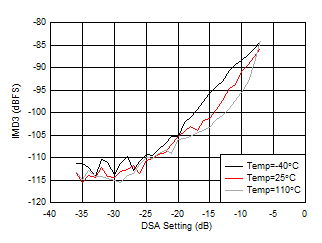
| With
3.5 GHz matching, 20-MHz tone spacing |
|
Figure 5-378 RX
IMD3 vs Input Level and Temperature at 3.6 GHz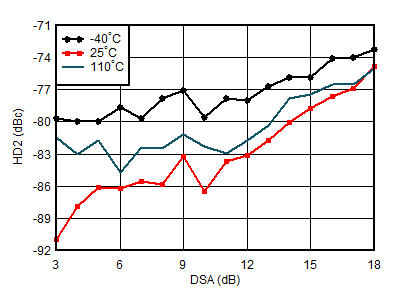
| With
3.5 GHz matching, DDC bypass mode (TI only mode for
characterization) |
Figure 5-380 RX
HD2 vs DSA Setting and Temperature at 3.6 GHz
| With
3.5 GHz matching, DDC bypass mode (TI only mode for
characterization) |
Figure 5-382 RX
HD2 vs Input Level and Temperature at 3.6 GHz
| With
3.5 GHz matching, DDC bypass mode (TI only mode for
characterization) |
Figure 5-384 RX
HD3 vs DSA Setting and Temperature at 3.6 GHz
| With
3.5 GHz matching, DDC bypass mode (TI only mode for
characterization) |
Figure 5-386 RX
HD3 vs Input Level and Temperature at 3.6 GHz Figure 5-388 RX
In-Band SFDR (±200 MHz) vs Input Level and Channel at 3.6 GHz
Figure 5-388 RX
In-Band SFDR (±200 MHz) vs Input Level and Channel at 3.6 GHz
| With
3.6 GHz matching, –7 dBFS each tone, 20-MHz tone
spacing, all supplies at MIN, TYP, or MAX recommended
operating voltages |
Figure 5-390 RX
IMD3 vs Supply Voltage and Channel at 3.6 GHz
| With
3.6 GHz matching, tone at –20 dBFS, 12.5-MHz offset
frequency, all supplies at MIN, TYP, or MAX recommended
operating voltages |
Figure 5-392 RX
Noise Spectral Density vs Supply Voltage and Channel at 3.6 GHz
| With
3.6 GHz matching, normalized to phase at 25°C |
Figure 5-367 RX
Input Phase vs Temperature at 3.6 GHz
| With
3.6 GHz matching |
| Differential Amplitude Error = PIN(DSA
Setting – 1) – PIN(DSA Setting) + 1 |
Figure 5-369 RX
Calibrated Differential Amplitude Error vs DSA Setting at 3.6 GHz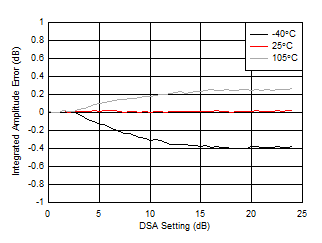
| With
3.6 GHz matching |
| Integrated Amplitude Error = PIN(DSA
Setting) – PIN(DSA Setting = 0) + (DSA
Setting) |
Figure 5-371 RX
Calibrated Integrated Amplitude Error vs DSA Setting at 3.6 GHz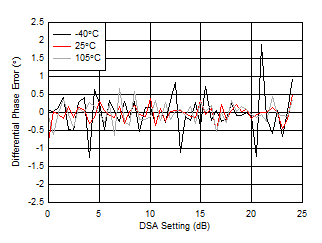
| With
3.6 GHz matching |
| Differential Phase Error = PhaseIN(DSA
Setting – 1) – PhaseIN(DSA Setting) |
Figure 5-373 RX
Calibrated Differential Phase Error vs DSA Setting at 3.6 GHz
| With
3.6 GHz matching |
| Integrated Phase Error = Phase(DSA Setting) – Phase(DSA
Setting = 0) |
Figure 5-375 RX
Calibrated Integrated Phase Error vs DSA Setting at 3.6 GHz
| With
3.5 GHz matching, each tone at –7 dBFS, 20-MHz tone
spacing |
Figure 5-377 RX
IMD3 vs DSA Setting and Temperature at 3.6 GHz
| With
3.5 GHz matching, DDC bypass mode (TI only mode for
characterization) |
Figure 5-379 RX
HD2 vs DSA Setting and Channel at 3.6 GHz
| With
3.5 GHz matching, DDC bypass mode (TI only mode for
characterization) |
Figure 5-381 RX
HD2 vs Input Level and Channel at 3.6 GHz
| With
3.5 GHz matching, DDC bypass mode (TI only mode for
characterization) |
Figure 5-383 RX
HD3 vs DSA Setting and Channel at 3.6 GHz
| With
3.5 GHz matching, DDC bypass mode (TI only mode for
characterization) |
Figure 5-385 RX
HD3 vs Input Level and Channel at 3.6 GHz
| With
3.5 GHz matching, 12.5-MHz offset from tone |
Figure 5-387 RX
Noise Spectral Density vs Input Level and DSA Setting at 3.6 GHz Figure 5-389 RX
SFDR Excluding HD2/3 vs DSA Setting and Channel at 3.6 GHz
Figure 5-389 RX
SFDR Excluding HD2/3 vs DSA Setting and Channel at 3.6 GHz
| With
3.6 GHz matching, –7 dBFS each tone, 20-MHz tone
spacing, all supplies at MIN, TYP, or MAX recommended
operating voltages |
Figure 5-391 RX
IMD5 vs Supply Voltage and Channel at 3.6 GHz

























